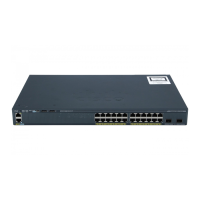If any root switch for the specified instance has a switch priority lower than 24576, the switch sets its own
priority to 4096 less than the lowest switch priority. (4096 is the value of the least-significant bit of a 4-bit
switch priority value. For more information, select "Bridge ID, Switch Priority, and Extended System ID"
link in Related Topics.
If your network consists of switches that support and do not support the extended system ID, it is unlikely
that the switch with the extended system ID support will become the root switch. The extended system ID
increases the switch priority value every time the VLAN number is greater than the priority of the connected
switches running older software.
The root switch for each spanning-tree instance should be a backbone or distribution switch. Do not configure
an access switch as the spanning-tree primary root.
Use the diameter keyword, which is available only for MST instance 0, to specify the Layer 2 network
diameter (that is, the maximum number of switch hops between any two end stations in the Layer 2 network).
When you specify the network diameter, the switch automatically sets an optimal hello time, forward-delay
time, and maximum-age time for a network of that diameter, which can significantly reduce the convergence
time. You can use the hello keyword to override the automatically calculated hello time.
Related Topics
Configuring the Root Switch, on page 62
Restrictions for MSTP, on page 42
Bridge ID, Device Priority, and Extended System ID, on page 17
Multiple Spanning-Tree Regions
For switches to participate in multiple spanning-tree (MST) instances, you must consistently configure the
switches with the same MST configuration information. A collection of interconnected switches that have the
same MST configuration comprises an MST region.
The MST configuration controls to which MST region each switch belongs. The configuration includes the
name of the region, the revision number, and the MST VLAN-to-instance assignment map. You configure
the switch for a region by specifying the MST region configuration on it. You can map VLANs to an MST
instance, specify the region name, and set the revision number. For instructions and an example, select the
"Specifying the MST Region Configuration and Enabling MSTP" link in Related Topics.
A region can have one or multiple members with the same MST configuration. Each member must be capable
of processing RSTP bridge protocol data units (BPDUs). There is no limit to the number of MST regions in
a network, but each region can support up to 65 spanning-tree instances. Instances can be identified by any
number in the range from 0 to 4094. You can assign a VLAN to only one spanning-tree instance at a time.
Related Topics
Illustration of MST Regions, on page 48
Specifying the MST Region Configuration and Enabling MSTP, on page 59
Prerequisites for MSTP, on page 41
Restrictions for MSTP, on page 42
Spanning-Tree Interoperability and Backward Compatibility, on page 24
Optional Spanning-Tree Configuration Guidelines
BackboneFast, on page 86
UplinkFast, on page 82
Catalyst 2960-XR Switch Layer 2 Configuration Guide, Cisco IOS Release 15.0(2)EX1
OL-29424-01 45
Configuring Multiple Spanning-Tree Protocol
Multiple Spanning-Tree Regions

